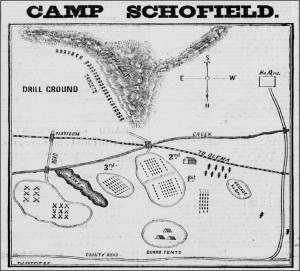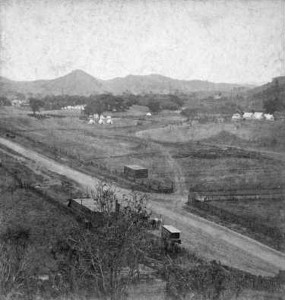By Rick Storms
The arrival of over 1,200 men of the Second Brigade of the California State Guard in the Ross Valley in May 1875 for a three-day training camp was a big event. The valley was then sparsely populated with probably less than 100 residents and only a few scattered homes. The North Coast Pacific Railroad had just recently completed its line through the valley and on west to the coast.
The site chosen for the encampment was on the western edge of San Anselmo on what was then the McCrea-Saunders Ranch, in the area between pres ent-day Center and Sir Francis Drake Boulevards. The camp was named after Major General John Schofield, the Commanding General of the Pacific Coast National Army, and was under the command of General James Coey.

This map from the May 21, 1875, issue of the Daily Alta shows the layout of the camp. The point where the creek and the railroad tracks intersect is the location of today’s Lansdale Station. The County Road is today’s Sir Francis Drake Boulevard. The target range, marked by “Rs,” follows roughly Elm Avenue. Headquarters, on the upper right, was located in the home of Peter Owen, formerly the home of Charles Fairfax. Note the lake just off the creek.
The soldiers embarked on a steamer at the Davis Street wharf in San Francisco for Pt. San Quentin where they boarded platform rail cars. In San Rafael, they were hailed by ladies waving handkerchiefs which they acknowledged by yelling “three cheers for the ladies of San Rafael.”
Three regiments of men, a regular cavalry company, and a brigade commander spread out over the large area with its oak-studded hills. A special area was established just for the rifle and artillery range, and a new road was created connecting the base camp to the range.
The purpose of the camp was to give the all-volunteer army a taste of what it was like to be in the theater of war. The men worked from sunup to sundown with taps sounding at 9 p.m. Activities included battalion and brigade drills, brigade guard mounting, artillery salutes, parades and roll calls.
In addition to drills and salutes, sharpshooting was the order of the day. The troops were issued new Springfield rifles and competitions were held between the regiments. The rifle and artillery range was located at the base of a hill that acted as a backstop for any stray bullets or shells. The public was invited to tour the camp and watch the rifle and artillery practice and competition. It was reported that about a thousand civilians viewed the events.
All was not as “professional” in the volunteer army as one might think. There were those who thought a bit of fun was in order. A group of men snuck away on Friday night for a good time in San Rafael. Upon returning to camp, their fun continued. They visited the headquarters of a company and aroused the entire command. The captain turned out the company, “hurrying them to arms as if they were under attack.” The jokesters then informed the captain that it was all a joke. The captain, not thinking this was funny, ordered his men to charge and caught the lead jokester and sent him to the guardhouse for the remainder of the encampment.
On the final day, California’s Governor Romualdo Pacheco and Senator Newton Booth visited the camp giving great delight to both the troops and the general public. All considered the encampment a major success. The echo of the drum roll, the booming artillery, and the shouts of “long live Camp Schofield” faded as the men boarded the train for home.

Camp Schofield in Ross Valley from stereograph by Carleton E. Watkins. View is to the southeast from roughly the Pastori and Sir Francis Drake intersection.

